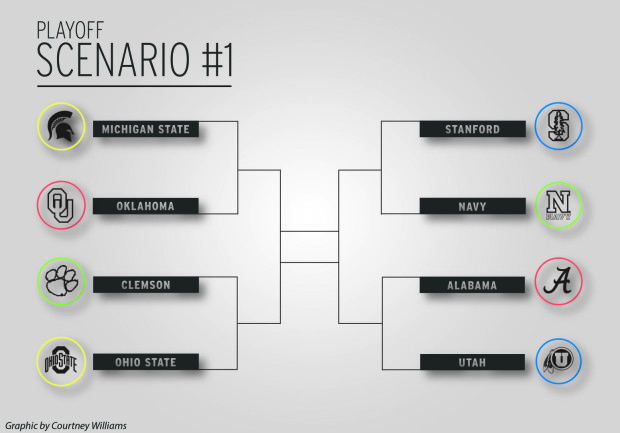
 Following the 2013 season when college football moved from the Bowl Championship Series to the new College Football Playoff, fans and pundits alike lauded the move as a step in the right direction. But while installing a playoff system was the right choice, a four-team playoff simply isn’t sufficient for the new world of college football.
Following the 2013 season when college football moved from the Bowl Championship Series to the new College Football Playoff, fans and pundits alike lauded the move as a step in the right direction. But while installing a playoff system was the right choice, a four-team playoff simply isn’t sufficient for the new world of college football.
There’s a lot of debate about what teams should and shouldn’t make it into the college football playoff, and with five power conferences and four spots, it creates the chance for some major problems.
Over the last two weeks of the conference realignment series, we’ve looked at the 72 teams populating the conferences and the basics of how the regular season scheduling would work.
In the final week, we’re looking at the proposed eight-team playoff that would be used in accordance with the new Power 4 conferences and put that system into practical application, using the 2015-16 season as a guide.
How it all works: Playoffs
Last week, we talked about how each conference champion earns an automatic bid into the playoffs, and that might upset some people, but allow me to explain.
In this model, the playoffs are expanded to an eight-team playoff, meaning each conference winner earns an autobid.
Then, the next four spots are up for grabs to the next best four teams. This is where the college football playoff committee comes into play. No, they didn’t lose their jobs in this scenario.
Much like this year, the college football playoff committee plays a big role in determining who’s in and who’s out. Starting after week nine of the season, they begin to rank their own top 25, which is the end-all, be-all ranking.
How this plays into the playoffs goes like this: They rank each conference champion first through fourth. Those are the top four seeds of the playoffs. The next four spots in the final poll are the next four seeds. So theoretically, a college football playoff could look like this:
Playoff Scenario 1
 Seed 1: Michigan State (Central Champion)
Seed 1: Michigan State (Central Champion)
Seed 2: Stanford (West Champion)
Seed 3: Alabama (South Champion)
Seed 4: Clemson (East Champion)
Seed 5: Ohio State (At-large bid from the Central)
Seed 6: Utah (At-large bid from the West)
Seed 7: Navy (At-large bid from the East)
Seed 8: Oklahoma (At-large bid from the South)
Playoff Scenario 2
Conversely, if one conference has a really good season, the playoffs could look like this:
 Seed 1: Michigan State (Central Champion)
Seed 1: Michigan State (Central Champion)
Seed 2: Stanford (West Champion)
Seed 3: Alabama (South Champion)
Seed 4: Clemson (East Champion)
Seed 5: Oklahoma (At-large bid from the South)
Seed 6: TCU (At-large bid from the South)
Seed 7: Ohio State (At-large bid from the Central)
Seed 8: UH (At-large bid from the South)
This way, each conference gets one team in the playoffs and can’t complain about missing out, but if one conference is clearly the best that year, and the committee sees it that way, it is rewarded for its hard work.
Since we’re expanding the playoffs, that means we need more locations for the games. I propose that the quarter-finals rotate between the New Year’s Six bowls, the Rose, Sugar, Orange, Cotton, Peach and Fiesta Bowls, much like the semi-finals do now.
That means four of those games are taken by playoffs, leaving two for the next four at-large teams.
The semifinals are now their own games, much like the championship game is now, with these games taking place at two of the locations of the quarterfinals. The championship game would take place at one of the other two sites not used for the quarters or semis, which means that no more than two games are played at any one site.
Playoff Logistic Scenario:
A hypothetical playoff from Scenario 1 looks like this:
CFP Quarterfinal: The Rose Bowl – Michigan State vs Oklahoma
CFP Quarterfinal: The Sugar Bowl – Stanford vs Navy
CFP Quarterfinal: The Fiesta Bowl – Alabama vs Utah
CFP Quarterfinal: The Orange Bowl – Clemson vs Ohio State
CFP Semifinal: College Football Semifinal 1 (Hosted at the Rose Bowl) Rose Bowl winner vs Orange Bowl winner
CFP Semifinal: College Football Semifinal 2 (Hosted at Sugar Bowl) Sugar Bowl winner vs Fiesta Bowl winner
CFP Final: College Football Playoff Championship Game (Hosted at the Cotton Bowl) Semifinal 1 winner vs Semifinal 2 winner.
The Cotton Bowl: Florida State (9th-ranked at large) vs Michigan (12th-ranked at large)
The Peach Bowl: LSU (10th-ranked at large) vs USC (11th-ranked at large)
Again, these rotate among the sites, so each location would get its chance to host each of these games.
This approach presents the fairest rendering of a playoff system. Each conference gets to send a representative to make a statement that it is the best in the conference.
Obviously, this is far from all the details that would need to be considered. But in a world where a system is never perfect, it’s always fun to play the role of the fixer. An eight-team playoff system offers the chance for a lower-seeded team to make a run at a national championship, mirroring the excitement of March Madness on a smaller scale, while also generating more revenue for the NCAA, sponsors and schools.
But on the most basic level, it offers more college football and what I see as a more even playing field, and in the end, we could all use an extra week or two of football in our lives.
—
“Conference realignment: 8-team playoffs and the dilemma of the autobid” was originally posted on The Daily Cougar
